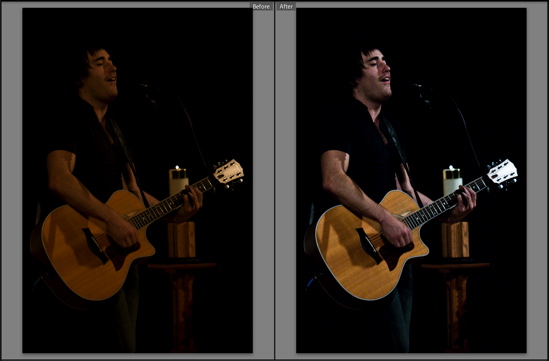On Friday, I attended a Phil Wickham concert; since I yam what I yam, I just so happened to have my camera in my hand during the show.
The lighting was essentially mood lighting, which is code for “not much”; the show was in a church, and there was no truly useful stage lighting with which to highlight the musician. So when they turned down the lights to achieve the preferred mood, they just made everything dim. In that situation, capturing usable images was a challenge — most concerts are challenges, but this one was even more of a challenge — and the images I did get required more work to take them from usable to worthwhile.
So, as an addition to the recent post concerning my photo processing, here is a before/after example from the Wickham show. (Click on the image to see the larger image.)
As the before image shows, to avoid an impossibly useless shutter speed (musicians are not inanimate objects!), I had to underexpose the images. Fortunately, uncompressed digital images are reasonably robust; after adjustments to the white balance and the exposure (among other things), the image isn’t stunningly award-winning, but it’s considerably improved.
Astute readers may wonder if the above picture is an example of my abandoning my own advice not to simply take a picture and plan to make it good on the computer; in response, I would say, “I never said that! It must have been another blog. Would you like a brownie?”
After the astute readers finished the brownies, I would also say that some situations require compromises in order to achieve a good end product; had I shot the Wickham show at a shutter speed that would have resulted in properly-exposed images, I would have ended up with a pile of blurry unrecognizable messes. I knew that I could work with an underexposed sharp image far more than I could work with a properly-exposed mess, so I made the necessary compromise to produce the sort of images I wanted. I don’t really want to make such compromises, but there are times they simply are not practically avoidable.


Dark or pasty white…I love my Phil Wickham.